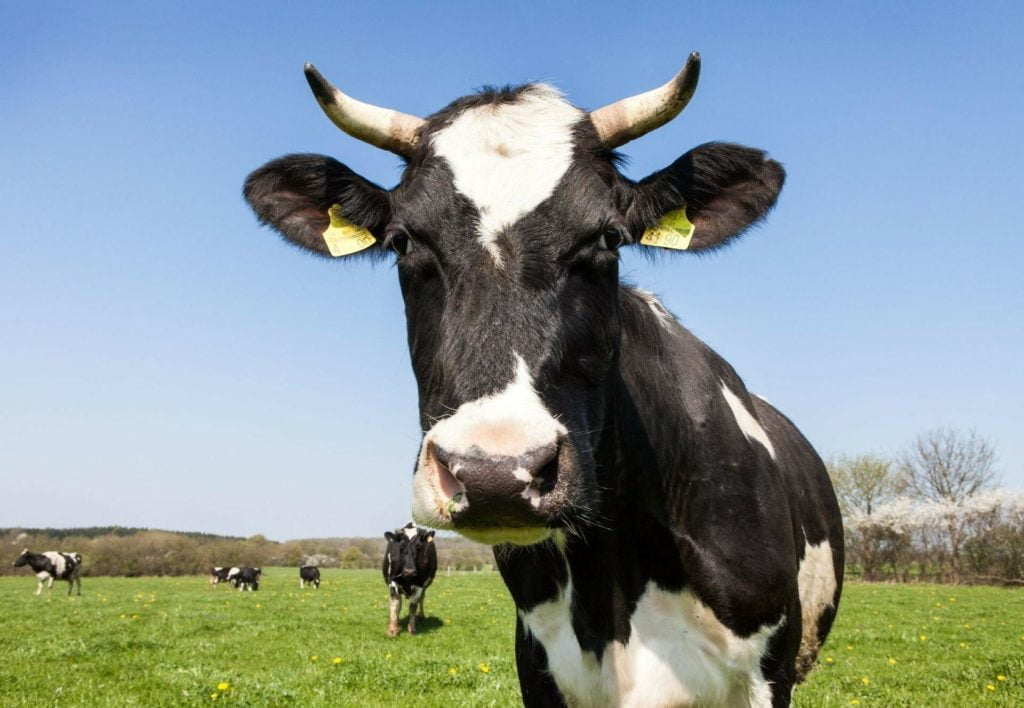
Returning the ‘Whole’ Cow to US Lunchrooms: Why Some Say Children Need Whole Milk
By Autumn Spredemann March 14, 2023
The age-old argument for keeping “healthy fat” in the human diet has gained new traction as farmers, legislators, and nutritionists lead a movement to return whole milk to schools.
This crusade is backed by research showing that whole milk delivers critical fat-soluble vitamins and contributes to a lower risk of Type 2 diabetes.
Advocates say U.S. children deserve to have the full spectrum of milk varieties available to them in the cafeteria.
It’s become a point of concern among nutrition experts since the amount of milk consumed in schools declined rapidly during the Obama-era ban on whole and 2 percent milk, which began in 2012.
That year, the U.S. Department of Agriculture (USDA) stopped the distribution of full-fat milk in lunchrooms.
Masked cafeteria workers serve food during a socially distanced lunch at Medora Elementary School in Louisville, Ky., on March 17, 2021. (Jon Cherry/Getty Images)
Milk consumption in schools began to decline in 2008, but it accelerated quickly once the USDA ban on full-fat dairy began.
Between 2008 and 2018, the average amount of milk consumed on a weekly basis per student dropped from 4.03 bottles to 3.39 bottles.
“Scientific evidence is really pointing to there being an overall survival advantage to the consumption of milk and dairy products,” Adam Lock told The Epoch Times.
Lock is an associate professor in the Department of Animal Science at Michigan State University. He said that milk, in general, contains many essential nutrients. This includes high-quality protein, minerals, and vitamins.
He also said there’s a growing body of evidence suggesting milk’s fatty acids offer health benefits.
The Skinny on Fat
“For far too long, milk fat got a bad rap due to the saturated fat content. All ruminant products will have high levels of saturated fat … but not all saturated fat is the same. In fact, milk probably has the most diverse matrix of different fatty acids,” Lock said.
Basically, to absorb fat-soluble vitamins, you need fat. Milk is loaded with vitamins, such as A and D, of this type.
“Fat-free milk would contain little to no fat-soluble vitamins since there’s no fat present,” Lock said.
Yet despite whole milk having the highest fat content, Lock stressed that the amount of fat is still pretty low.
“As an aside, it’s also important to remember that whole fluid milk still only contains 3.25 percent fat. Much less than what most people think.”
So how did higher-fat varieties of milk disappear from schools? It was part of former President Barack Obama’s crusade to create healthier lunchroom options.
Farmers and legislators are now taking action to give children the right to drink whole milk.
During a February Congressional hearing, Sen. Roger Marshall (R-Kan.) expressed concern over kids being deprived of the health benefits of whole milk.
Sen. Roger Marshall (R-Kan.) at a Senate panel on June 16, 2022. (The Epoch Times via the Senate Health, Education, Labor, and Pensions Committee)
Speaking from his experience as a physician, Marshall said, “We’re going to have a generation of men and women with osteoporosis a decade sooner than a generation where we were all raised on whole milk.”
Pennsylvania Farm Bureau President Rick Ebert told reporters during a March 2022 press conference, “Schools should have the ability to provide healthy options for students … whole milk contains a number of key nutrients essential for good health and is a more flavorful product.”
Ebert’s comment was a response to state House Bill 2397, which allows schools to distribute whole and flavored milk, so long as it’s produced and bottled in Pennsylvania.
A House committee unanimously approved the bill on March 30, 2022.
Similar legislation has been presented within the past few years. In 2019, U.S. Sens. Ron Johnson (R-Wis.) and Pat Toomey (R-Pa.) introduced the Milk in Lunches for Kids (MILK) Act, granting schools the right to serve all forms of milk, including whole.
“Overregulation has limited the healthy varieties of milk schools can serve students. Since these Obama-era regulations went into place, milk consumption has notably declined in schools across the country,” Johnson said.
Farmers have also joined the fight to return whole milk to schools.
A dairy farm in Westby, Wis., on Oct. 3, 2020. (Kerem Yucel/AFP via Getty Images)
“Full-fat milk is not a demon. Full-fat milk is the most amazingly nutrient-rich food you can possibly consume,” the president of Ronnybrook Farm, Richard Osofsky, told reporters.
Dairy producers in Wisconsin and Kansas also support the movement to bring back whole milk, hoping to capitalize on Pennsylvania farmers’ grassroots efforts that ended with favorable legislation.
However, despite research supporting its benefits, not everyone thinks whole milk should be offered in schools.
The Jury Still Out
“I don’t see any nutritional advantages to offering whole milk to school-aged children, and with consideration to childhood obesity rates, I am not in favor of it,” Jennifer Masters told The Epoch Times.
Masters is a certified LEAP (lifestyle, eating, and performance) therapist—a specially trained dietician—at Integrative Nutrition Solutions. She said it’s important to remember that the jury is still out when it comes to consuming the kind of fat found in whole milk.
“The impact of saturated fat consumption continues to be one of the leading controversies in nutritional science,” she said.
“It is clear that saturated fat in the diet raises LDL cholesterol levels. However, whether or not LDL cholesterol levels contribute to cardiovascular disease in a particular individual likely depends on several other factors.”
Secretary of Agriculture Tom Vilsack speaks during a video conference with farmers, ranchers, and meat processors held by President Joe Biden in Washington on Jan. 3, 2022. (Jonathan Ernst/Reuters)
But Lock said cholesterol alone isn’t a good yardstick for measuring the health effects of full-fat dairy.
“Changes in cholesterol levels are only one risk factor for heart disease. The premise that the diet-heart hypothesis was based on was fatally flawed from the outset,” he said. “We know that drinking milk can raise cholesterol somewhat, but it raises HDL and LDL. The ratio is perhaps most important for this one risk factor.”
Though when it comes to obesity rates in children, studies have surprisingly linked whole milk consumption to reduced childhood obesity rates.
A 2020 meta-analysis revealed that higher cow milk fat consumption was associated with lower juvenile obesity in 18 studies.
However, Secretary of Agriculture Tom Vilsack defended the USDA decision to remove full-fat dairy from cafeterias, saying the nation has been on the “right track” with school meals since 2010.
His comment reinforces a national strategy under President Joe Biden to end hunger and diet-related diseases by 2030.
And school lunch programs are a pivotal part of this strategy.
The Food and Drug Administration also proposed new regulations to further tighten this belt by redefining nutritional guidelines and what qualifies as “healthy” food.
New regulations are currently set to come into force during the 2024–2025 academic year.
